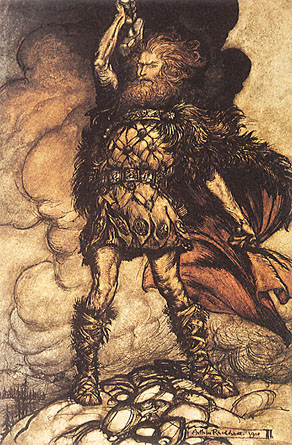

Part VI: Norse Religion Today
The practice of worshipping the Norse gods couldnít die entirely. The memory of Odin, Thor, Tyr, Freyr, and others were kept alive through the ages by an interest in the old poems and folklore of days long ago. In the middle 1600ís, Norse mythology began to once again grow in popularity. However, worship of the Norse gods only began to reach re-emerge in any great number within the last twenty or thirty years. Today, there are two major groups involved in the practice of Norse religion: Asatru and Wicca. In either case, the practitioner of Norse religion usually finds himself attracted to a particular god. As a previous quote from H.R. Ellis Davidson stated, Norse religion is an individual affair.
Asatru is the more traditional of the two. The name itself means something along the lines of "Loyalty to the Gods." Its faithful look to the Eddas as a guide to daily life and celebrate many of the same holidays the Norsemen did. Most important is Norse feast is Yule, which falls right near Christmas. This is seen as the time when spirits of the dead could once again walk the earth, and it is a time to honor and remember the ancestors. Several Christmas traditions are in fact derived from the feast. For example, burning the Yule log, decking the halls with holly or evergreen, and hanging stockings are all apart of the heathen tradition. The most important aspect of Yule is it marks the time when the old year becomes the new. The time from December 20th to January 1st is known as Wih-Nights, and it is the most magical time of the year.In daily life, Asatrur try to live according to virtues admired by the Norsemen, like honor, courage, loyalty, honesty, and cheerfulness. Wisdom poems like The Lay of Sigdrifa and Sayings of the High One form the moral creed of many Asatrur. As a matter of fact, Sayings of the High One is taught in Icelandic schools to this day. And like in the old days, Thor is still held as one of the highest of gods.
Norse Wicca is different from Asatru. The gods are usually the same, but some sects of Wicca have different ways of viewing the gods. Some groups believe all gods are one god and all goddesses are one goddess. Others see the gods in a triple pattern of hunter-warrior-sage and the goddesses as the virgin-mother-crone. In either case, each aspect sees the gods as fitting into one of the three stages of life (youth/maturity/old age). Other Wiccans see the gods as individual entities. A follower of Norse Wicca is likely to have similar ideals as the follower of Asatru, but most Wiccans are guided by the Rede, which is "Harm none." Popular gods among Norse Wiccans are Thor, Odin, Freyr, and Freyja.
Conclusion: Norse Religion in the World Today
So how can a religion that dates back thousands of years be practical in an age of science and technology? Times may have changed since the first man or woman invoked Thor or Tyr or Odin, but there is still a need in this world for the many virtues stressed in the poems of the Eddas. They preach a timeless message of the need for honor and the importance of friendship. The Norse pagan seeks to live life in such a way that would make his forefathers proud, a life where the individual can rise up to meet any challenge with unequalled courage and face any hardship with a laugh and a smile. The wisdom of the ancients taught the value of moderation and independence. The Vikings were violent at times, and they waged their share of wars, but what culture hasnít? While the Norsemen were warriors, they had a certain understanding for the value of life and especially the power of friendship:
"I was young once, I travelled alone,
then I found myself going astray;
rich I though myself when I met someone else,
for man is the joy of man."
-Sayings of the High One: 47
Their wisdom calls to us even today. The old gods did not die. The world may need them now more then ever.